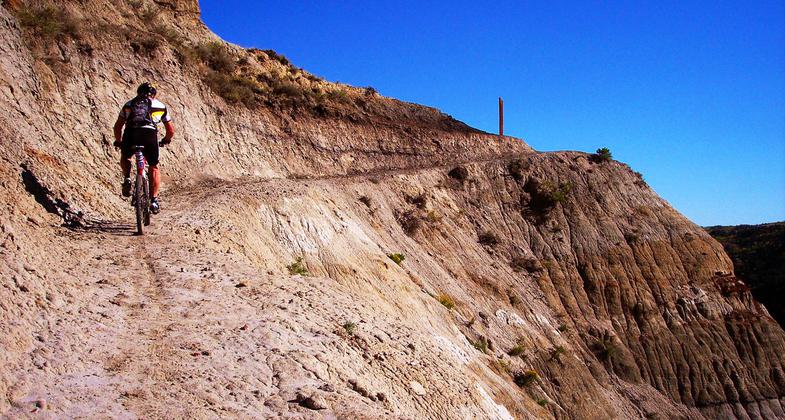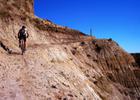Maah Daah Hey
check with the trail manager for updated details before visiting.
Maah Daah Hey
USDA Forest Service
Backcountry Trail
- Length
144.28 miles
- Elevation Gain
--
- Route Type
out & back
- Length
144.28 miles - Elevation Gain
-- - Route Type
out & back
The MDH trail is the longest trail in the Dakota Prairie Grasslands, and traverses the Badlands, starting from south of Medora at Burning Coal Vein Campground and moving all the way to CCC Campground south of Watford City. The MDH also connects the South and North Units of Theodore Roosevelt National Park.

Biking the Maah Daah Hey. Photo by Lorne Reimer.

Nick's volunteer efforts to save the Maah Daah Hey from overgrowth, erosion and extinction. Photo by Chad Ziemendorf.

Photo by Chad Ziemendorf.

Photo by Chad Ziemendorf.

Photo by Chad Ziemendorf.

Photo by Chad Ziemendorf.

Photo by Chad Ziemendorf.

Photo by Chad Ziemendorf.

Photo by Chad Ziemendorf.

Location: The Maah Daah Hey traverses the Little Missouri Grasslands in western North Dakota.
- States: North Dakota
- Counties: Billings, Golden Valley, McKenzie, Slope
- Cities/Townships: Amidon, ND; Medora, ND; Watford City, ND
The Maah Daah Hey (MDH) trail is the longest trail in the Dakota Prairie Grasslands, and traverses the Badlands, starting from south of Medora at Burning Coal Vein Campground and moving all the way to CCC Campground south of Watford City. The MDH also connects the South and North Units of Theodore Roosevelt National Park (TRNP). Bicycles are not allowed in TRNP. Cyclists wanting to continue the MDH trail will need to use Buffalo Gap trailhead to avoid the South Unit and exit the trail before they reach the North Unit. When the MDH trail passes through the South Unit into the Theodore Roosevelt Wilderness, there are multiple side trails that can be accessed to make loops. Please visit the TRNP website for more information. Campgrounds are located roughly twenty miles apart.
History of the Trail
The name Maah Daah Hey is derived from the Native American Mandan language. The Mandan language is considered a picture language, in that a phrase or single word is used to describe a picture, feeling, or situation. Maah Daah Hey means "Grandfather" or "long-lasting," and is used to describe the area as having been around for some time and deserving of respect.
The turtle symbol used on the trail confidence markers is the adopted symbol of the MDH. In the Lakota Sioux language, the turtle signifies determination, patience, long life, steadfastness, and fortitude. The shell of the turtle also symbolizes protection.
Connecting the North and South units of the TRNP and the Elkhorn Ranch Unit was an idea that originated in the 1960s. The Forest Service thought it would be a great idea for a road to be constructed, and Russ Alexander, a civil engineering technician, spent about two weeks looking for feasible routes through the badlands. Due to rough terrain and the economic conditions at the time, the idea for the MDH soon lost its appeal and was tabled until the mid-1980s.
The MDH idea resurfaced in 1988 and a horse ride was organized to evaluate the trail. The ride covered the proposed area that the trail was to meander through and a route was proposed. A group of interested folks began working together on the MDH project. After another ride in 1989 and the establishment of an MOU with North Dakota Parks and Recreation (NDPR), TRNP, and the Forest Service, Custer Forest Supervisor Curtis W. Bates approved the NEPA document in 1992 allowing construction to begin. Three years were needed to secure funding and trail construction began in 1995. The original 96-mile trail was completed in 1999 and it was designated a National Recreation Trail in 2002.
This National Recreation Trail nomination extends the MDH by 48 miles. This extension was referred to as the MDH 2, the Deuce, and the Southern Extension of the MDH until recently being combined with the original MDH. The plans and associated NEPA to build the MDH 2 began in 2000. The environmental assessment was completed in 2007 and construction began in 2008. An additional campground and five trailheads were also constructed along the 48-mile extension. A grand opening for the trail system was held in 2014. A small section of trail south of Sully Creek State Park and between the extension and the original trail remained unconstructed due to difficulties negotiating an easement on private land. NDPR was able to secure easements and construct the final two-and-a-half miles of trail between the original trail and the extension in 2015. The new route extended the trail to the Burning Coal Vein campground. This nomination would unify the entire trail as one National Recreation Trail from beginning to end.
Description of the Trail
The MDH trail is a 144-mile-long recreation trail that winds its way through the rugged badlands and rolling prairies of western North Dakota. The badlands are the most scenic part of the Grasslands, consisting of canyons and ravines that were carved into the landscape by perpetual wind and water erosion. The MDH is a non-motorized trail and is nationally recognized as a premier backpacking, mountain biking, and horseback riding trail. Along with the main trail, there are four miles of secondary trails connecting the campsites and trailheads to the MDH. Many different types of recreationists, from mountain bikers to hunters, use the trail.
The focus of both construction and location of the MDH was intended to minimize erosion and maintenance. A grade of 10% or less was used throughout the construction of the trail, intermingled with some short, steep pitches. The trail has eleven bridges, ranging in length from 16' to 35', to cross larger drainages. Approximately 121 miles of the MDH are on National Grasslands, ten miles on National Park Service land, nine miles on State lands, and four miles on Private lands. NDPR holds the easements for the sections of trail crossing state and private lands. The Forest Service has two private land easements. The south trailhead is located ten miles northwest of Amidon, ND at Burning Coal Vein campground (Mile Post 0.0). The trail passes Medora, North Dakota where trail users can use a public ROW as an access route between the MDH and town. The north trailhead is 15 miles south of Watford City, North Dakota, at the CCC campground (Mile Post 144). There are eight campgrounds along the trail.
Accessibility Information
No text provided.
Allowed Uses:
Bicycling Equestrian Hiking/WalkingPublic Contact
Greg MorelUSDA Forest Service
99 23rd Ave West
Dickinson, ND 58601
[email protected] • (701) 227-7854
www.fs.usda.gov/dpg
Contact the trail manager for current maps and visiting details.
More Details
- Elevation (low): 1975
- Elevation (high): 2950
- Elevation (cumulative): --
- Part of a Trail System? No
- Surface (primary): Soil
- Surfaces (additional): Grass or Vegetation, Rock, crushed, Soil
- Tread Width (average): 18"
- Tread Width (minimum): --
- Running length (minimum): --
- Tread Grade (average, percent): 8
- Tread Grade (maximum): 20
- Running length (maximum): --
- Cross-slope (average, percent): --
- Cross-slope (maximum): --
- Running length (maximum): --
- Certified as an NRT
Dec 13, 2016

